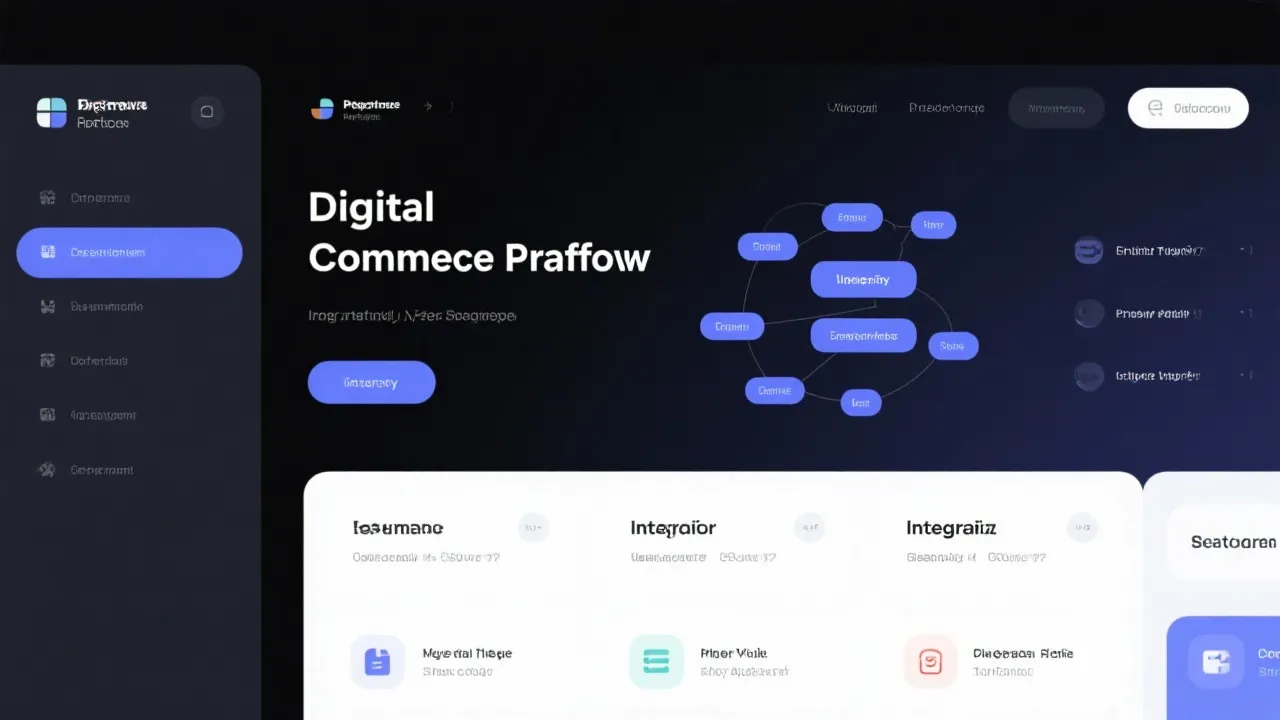Comparing Vtex and Salesforce Commerce
Discover the intricacies of Vtex and Salesforce Commerce, leading e-commerce platforms that cater to diverse online businesses. Vtex offers a scalable and flexible solution known for its collaborative ecosystem, while Salesforce Commerce shines with its integration capabilities and robust CRM features. Choosing between them depends on business needs, such as desired features and integration possibilities.

Introduction to E-commerce Solutions
In the rapidly evolving world of online retail, choosing the right e-commerce platform is a fundamental decision for any business. This not only impacts how your business operates today but also influences its future growth potential. Among the top contenders in this space are Vtex and Salesforce Commerce, both of which offer unique strengths and opportunities to businesses seeking effective online presence.
The Rise of E-commerce Platforms
In recent years, e-commerce has become a powerhouse sector, driving unprecedented innovation and competition among platforms vying to capture a piece of the market. Essentially, an e-commerce platform provides the necessary technological and business framework to build and operate online stores, manage customer relationships, and carry out online transactions. As businesses pivot from brick-and-mortar operations to digital channels, platforms like Vtex and Salesforce Commerce have become saviors, helping them seamlessly transition into the virtual marketplace.
With the proliferation of internet access and the increasing use of mobile devices, e-commerce has broadened its reach, allowing customers to shop from anywhere at any time. In fact, according to recent statistics, global e-commerce sales reached over 4.28 trillion USD in 2020 and are expected to grow to about 6.39 trillion USD by 2024. This astronomical growth exemplifies the increasing reliance on digital marketplaces and the necessity for businesses to establish a solid online foundation.
Vtex: Features and Benefits
Vtex distinguishes itself as a dynamic e-commerce platform known for its multi-tenant and collaborative commerce functionalities. With a comprehensive suite of features, it empowers businesses to scale efficiently while catering to diverse markets. One of its standout features is its capability to facilitate complex supply chain operations, enabling retailers to manage inventory and coordinate smooth logistics across different regions.
Another significant advantage of Vtex is its built-in marketplace capabilities. Businesses using Vtex can quickly create and manage marketplaces, allowing third-party sellers to offer their products on the company's website. This creates a diverse range of products available for customers while also enabling the main business to earn commissions on sales made by third-party vendors.
Vtex also utilizes a low code development environment, allowing for easier customization and modifications without the need for extensive programming knowledge. This empowers businesses to adapt quickly to market changes or customer preferences and maintain a competitive edge in the fast-paced world of e-commerce.
Salesforce Commerce: An Overview
Salesforce Commerce, formerly known as Demandware, is renowned for its versatility and integration with Salesforce's robust ecosystem. It synergizes customer relationship management (CRM) capabilities with e-commerce functionalities, making it an attractive solution for businesses focused on customer-centric strategies. Additionally, Salesforce offers artificial intelligence-driven insights, which businesses leverage to deliver personalized shopping experiences.
The platform shines in industries where personalized customer interaction is crucial. Its artificial intelligence-driven Einstein feature offers predictions, recommendations, and deeper customer insights that help businesses cater to their customers' unique preferences. Moreover, Salesforce Commerce supports a plethora of marketing tools which can enhance customer engagement through targeted campaigns and promotions.
Salesforce also stands out for its extensive analytics and reporting capabilities, enabling businesses to track performance metrics efficiently. This data-driven approach empowers organizations to make informed decisions about product offerings, marketing strategies, and customer engagement tactics.
Platform Comparison: Vtex vs. Salesforce Commerce
When diving deeper into the comparison, it's apparent that both platforms have distinct features that cater to different business requirements. Below is a side-by-side assessment of their core attributes, strengths, and potential drawbacks.
| Aspect | Vtex | Salesforce Commerce |
|---|---|---|
| Scalability | Highly scalable for larger operations, enabling businesses to respond to increased demand smoothly. | Excellent scalability with CRM integration, allowing businesses to adapt as their sales and customer base grows. |
| Flexibility | Flexible with multi-tenant capabilities that allow businesses to operate multiple storefronts from a single instance. | Flexible with strong customization options supporting diverse business models and branding requirements. |
| Integration | Robust integration with various third-party services, giving businesses the ability to expand functionalities through plugins. | Seamless integration within the Salesforce ecosystem, offering access to an extensive range of tools and services. |
| Target Market | Medium to large enterprises looking for a collaborative commerce ecosystem with a focus on scalability. | Enterprises focusing on CRM-driven growth, emphasizing customer experience and data utilization. |
| Pricing | Flexible pricing models that scale with business needs, often favoring larger transaction volumes for cost-effectiveness. | Pricing may be more rigid due to its deep integration features and Salesforce CRM products, but offers a wide array of tools for investment. |
Web Hosting and Security
Security is paramount in e-commerce, and both Vtex and Salesforce offer solid security measures. Vtex ensures its sites have SSL encryption, data protection, and secure payment gateways, which are vital in protecting customer information and fostering trust. Additionally, Vtex implements proactive monitoring to identify and mitigate threats in real-time, enhancing the security of its infrastructure.
On the other hand, Salesforce complements its offerings with high-level cybersecurity protocols, leveraging the trust and reliability of its broader cloud services infrastructure. Salesforce employs a rigorous approach to data protection through regular security audits, ensuring compliance with various international regulations and standards such as GDPR. Their commitment to data privacy and protection is essential for businesses in heavily regulated industries.
Moreover, the Salesforce platform offers continuous updates and patches to unblock vulnerabilities proactively, illustrating a commitment to security that businesses can rely on. For organizations operating globally, the ability to adhere to local compliance standards in different regions through built-in security features is a significant advantage of choosing Salesforce Commerce.
Customer Support and Community
A comprehensive support system can significantly enhance a platform's user experience. Vtex offers a robust community of partners and developers that fosters collaboration and innovation. This active community contributes to a rich knowledge base, vibrant forums, and numerous useful resources for businesses navigating the platform.
Salesforce, known for its Trailblazer community, provides extensive resources, training, and support forums, which can be invaluable to businesses adopting the platform. Moreover, Salesforce invested in creating comprehensive educational programs through Salesforce Trailhead, enabling users to learn various aspects of the platform at their own pace. The vast knowledge-sharing environment encourages continual learning and adoption of best practices, thereby increasing user confidence and satisfaction.
In addition to community support, both Vtex and Salesforce provide dedicated customer service options, including phone support, live chat, and personalized assistance, ensuring businesses can promptly address technical questions or challenges they may face during the implementation phase or operational processes.
Success Stories: Case Studies
To better understand the capabilities of both Vtex and Salesforce Commerce, let's review some successful implementations of each platform.
Case Study: Vtex Implementation
One notable success story involves the Brazilian retail giant, Centauro, which specializes in sports and athletic apparel. After transitioning to the Vtex platform, Centauro significantly enhanced its online shopping experience, boosting conversion rates and increasing its customer reach. With Vtex’s marketplace features, Centauro could introduce new products from various suppliers and simplify managing logistics through a cohesive system that handles inventory across numerous departments. As a result, Centauro reported a 40% increase in online sales within the first year of adopting Vtex.
Case Study: Salesforce Commerce Implementation
Another compelling case study comes from Adidas, which leverages Salesforce Commerce to optimize its direct-to-consumer business model. By harnessing the capabilities of Salesforce's CRM and its commerce functionality, Adidas can provide personalized experiences that leverage customer data, enhancing customer engagement during the shopping journey. The data-driven insights garnered through the platform have allowed Adidas to tailor marketing strategies and provide customers with relevant product suggestions and promotions. These efforts resulted in higher customer retention rates and a marked increase in average order values.
Conclusion: Choosing the Right Platform
The choice between Vtex and Salesforce Commerce ultimately boils down to the specific needs of a business. Vtex is ideal for companies looking for fast scalability and a collaborative commerce ecosystem, particularly in sectors requiring complex supply chain management. Companies that want tight integration with CRM capabilities and deep customer insights to enhance the shopping experience will find Salesforce Commerce to be more aligned with their objectives.
Furthermore, when evaluating which platform to adopt, businesses must consider the long-term vision. Are they aiming for rapid growth and diversification? Or do they prioritize powerful customer relationship management and personalization? The answer to these questions will help potential users to navigate between Vtex and Salesforce Commerce effectively.
FAQs
What is the primary focus of Vtex?
Vtex is primarily focused on facilitating collaborative commerce and providing scalable solutions for complex supply chains. Its multi-tenant design allows for high flexibility and rapid growth.
How does Salesforce Commerce integrate with CRM?
Salesforce Commerce seamlessly integrates with Salesforce's CRM, allowing for coordinated data sharing and enhanced customer management. This integration supports a truly customer-centric approach to e-commerce.
Which platform offers better security?
Both platforms offer robust security features. Vtex focuses on secure transactions with extensive protection measures, while Salesforce leverages its comprehensive cloud security infrastructure, providing a high level of security and compliance with global standards.
Can businesses manage multiple storefronts using these platforms?
Yes, Vtex enables users to manage multiple storefronts efficiently from a single instance, thanks to its multi-tenant architecture. Salesforce Commerce also allows for customized storefronts, but the primary strength lies in its deep integration capabilities with CRM functionalities.
Are there significant differences in pricing between the two platforms?
Pricing for both platforms can vary significantly based on the specific services, usage models, and integration requirements an enterprise chooses. Vtex typically offers flexible pricing models that scale with business needs, while Salesforce might be seen as higher in cost due to its extensive range of tools and capabilities associated with its CRM products.
Future Trends in E-commerce Solutions
As we move further into the digital age, e-commerce solutions will continue to evolve, addressing emerging consumer needs and technological advancements. Here are some anticipated trends that businesses should consider when navigating the e-commerce landscape:
1. Enhanced Personalization
The expectation for personalized experiences will continue to grow, driven by advances in artificial intelligence and machine learning. E-commerce platforms will increasingly implement AI-powered tools that analyze customer behavior, enabling businesses to curate individualized experiences, recommend products, and create dynamic content based on user interactions. Brands that excel in personalization will likely see increased customer loyalty and engagement.
2. Omnichannel Strategies
Today's consumers often engage with brands across various channels. To address this reality, successful businesses will need to implement omnichannel strategies that provide a cohesive shopping experience, whether online, in-store, or through mobile applications. This integration will require e-commerce platforms to support cross-channel functionality, allowing customers to move seamlessly between different touchpoints.
3. Mobile Optimization
With the increasing prevalence of smartphones, mobile optimization of e-commerce sites is becoming essential. E-commerce platforms must prioritize mobile-first designs and develop features such as responsive layouts and one-click purchasing. In addition, integrating mobile wallets and contactless payment methods will enhance the shopping experience, catering to the growing number of consumers who prefer to shop through their mobile devices.
4. Sustainable Practices
As consumers become more environmentally conscious, e-commerce platforms will need to incorporate sustainability into their business models. This may include promoting eco-friendly products, sustainable shipping methods, and transparent supply chains. Brands perceived as environmentally responsible are likely to gain favor among consumers, leading to increased sales and loyalty.
5. Augmented Reality and Virtual Reality
The integration of Augmented Reality (AR) and Virtual Reality (VR) into e-commerce experiences presents exciting opportunities for businesses. AR and VR can provide customers with immersive experiences, such as virtual fitting rooms for clothing or interactive product demonstrations. This technology not only improves customer engagement but also reduces the likelihood of returns, as customers can visualize products before purchasing.
6. AI-Driven Customer Support
As businesses seek to enhance customer service and reduce response times, AI-driven chatbots and virtual assistants will become increasingly common. These tools can assist customers 24/7, addressing queries, offering support, and even facilitating transactions without human intervention. As such technologies continue to improve, businesses will experience greater efficiency and customer satisfaction.
7. Subscription Services
The subscription model is gaining traction in various industries, including e-commerce. Brands are now exploring subscription services that offer curated products on a recurring basis, providing convenience for consumers. This model not only ensures steady revenue for businesses but also fosters customer loyalty through continuous engagement.
Conclusion: Preparing for the Future of E-commerce
The future of e-commerce solutions is bright, with innovations continuing to shape how businesses operate and interact with consumers. Both Vtex and Salesforce Commerce are positioned to help companies leverage these advancements effectively. As you contemplate which platform is right for your business, it is essential to align your choice with long-term goals, customer expectations, and the capacity for growth.
Investing time and resources into the right e-commerce solution can lead to substantial future rewards. Understanding emerging trends, adapting to shifting consumer preferences, and maintaining a customer-centric outlook will ultimately determine the success of e-commerce enterprises in an increasingly competitive landscape. As you embark on your journey, ensure you remain agile and responsive to the fast-paced world of online retail, embracing both the challenges and opportunities it presents.
-

A Guide to Cost-Efficient Small Electric Cars for Seniors
-

Mastering Debt Consolidation: Boost Your Credit Score and Manage Interest Rates
-

Your Guide to Loans, Credit Checks, and Interest Rates
-

Affordable Independent Living: Finding the Right Senior Housing
-

Guide to Senior Living Apartments: Affordable and Comfortable Environments









